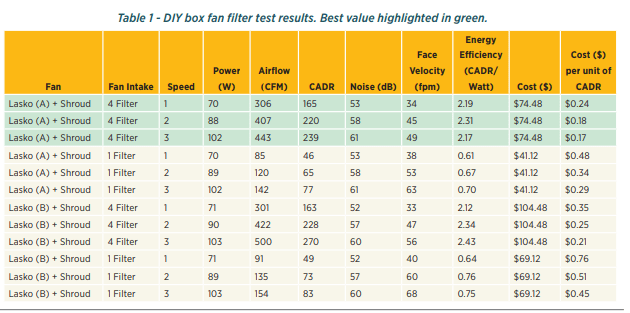
JesseSmith
Bio
The only blue collar EA.
I have a background in carpentry and HVAC. Co-own an exotic lumber store & furniture shop with a mill and kiln. I do building diagnostics and the technical aspects of design. My company has performed ~2k energy retrofits.
How I can help others
Anything to do with buildings, even if only peripherally related.
Posts 1
Comments26
Bummer. Operating at 25 db would have been really impressive for a room filter but it looks like it's not even close. Extrapolating from David Elfstrom's airflow estimates it looks like ~1/2 cfm would put it >40 db, which isn't great. So if we want to create a satisfactory occupant experience we probably shouldn't put down the tin snips just yet.
Ah, sorry, the CR reference threw me off. That link seems to suggest those are in the 40 db range.
Duct design uses equivalent length as a metric across duct types and fittings with 1 foot of straight metal pipe as a '1'. The problem with flex is that each foot has an equivalent length of 1.5, which adds a moderate amount to system length (although to keep this in perspective many near air handler transitions are >100'). For something like this I'd probably do a short run of flex near the motor (both sides) to dampen motor/vibration noise and transition to metal beyond. Avoid cornering with flex! In general, remote fans, eliminating line of sight on the motor and oversizing ducts/terminations will be shockingly quiet to most room occupants. If you want to get super clever, you can start doing offset openings in walls by cutting grilles high on one side and low on the other, but it can be difficult to pull sufficient air while keeping velocity low (400 cfm = 6 stud bays).
Btw this might sound trivial, but for people with a central ducted HVAC system it's quite common for the central fan to pressurize/depressurize rooms with closed doors, which in some cases will be the largest driver of infiltration. So simply having an AC or furnace cycle on and off during the experiment would be quite bad for the results.
It's an OK experiment, but there could be other reasons for air exchange in the room that vary quite widely. Building infiltration would exchange air with outdoors and varies quite a bit with outdoor conditions. It's also not very difficult to measure airflow so I don't see many disadvantages to doing so
Are you limiting your noise estimates to strictly airflow/static pressure? The research I'm aware of suggests Corsi boxes perform at >40db and up to 60db on high speed (~350 cfm). https://housefresh.com/corsi-rosenthal-box-review . During the pandemic this was widely discussed as a major impediment to their adoption.
Upsizing terminations substantially reduces room-facing air velocity. Assuming 400 cfm, the velocity at the termination I link will be roughly 175 fpm. This is extremely low, and I'd expect to achieve 20-25 db. Most residential return registers are undersized and thus outside ACCA's duct design standard of 500 fpm. It's also less than standards widely used for quiet spaces (200-300 fpm). You could continue pursuing improvements here via upsizing further if you're so inclined, or using clever placement to put the filtration system away from the room activities or behind (offset) cabinetry or furnishings.
My experience is mainly in central HVAC systems and I mostly agree that filters could have a much long service life. However, I've seen significantly shorter life via fine particulate via the use of tap water in humidifiers. Ime this will clog a MERV 13 filter in a few weeks. If you can afford a manometer (~$100) capable of reading increments of IWC ~.1, testing pressure is quite simple and many more people would benefit from adding this type of measurement to their skillet! I'm happy to provide further guidance!
Fan energy is a mixed bag depending on motor type. Constant airflow fans have a fairly flat pressure:CFM curve and will increase energy but PSC motors will see much lower airflow and reduced energy as a consequence.
In heat/AC systems airflow reductions outside a fairly narrow range will cause shutdown/failure due to high heat/freezing coils. In filter only systems you'd probably see low airflow and premature motor burnout. In standard motor assemblies going beyond .2 iwc increase would widely be considered quite aggressive (I have a fairly high risk tolerance for crazy stuff in buildings and probably wouldn't do this)


Good thoughts! We run the exact respirator you link working in attics continuously for many hours/day. Disc filters last an extremely long time. This model can also be paired with an organic vapor cartridge and particulate pre-filter.
https://www.amazon.com/3M-Performance-Facepieces-NIOSH-APPROVED-6001P3-DC/dp/B00KX1IFNK/
https://www.amazon.com/3M-Particulate-Filter-5-pairs-Filters/dp/B0013Z0TV6/